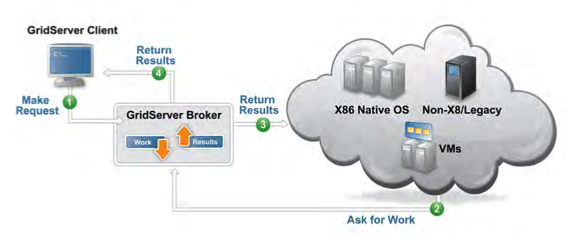TIBCO is moving its grid computing software to the cloud, starting with its GridServer product. The company is leveraging the Amazon Web Services computing infrastructure to provide customers with an easier and less expensive way to access its advanced grid computing technology. TIBCO Silver allows customers to pay only for the resources they use – with no upfront investments or long-term commitments. To get the full story on this venture, I spoke with TIBCO’s Director of Product Marketing Ivan Casanova.
 Casanova was the also the chief marketing officer for DataSynapse, which was purchased by TIBCO in 2009 for approximately $28 million in cash. The company’s flagship product GridServer was one of the more successful commercial grid computing products out there, and still has a solid customer base, with more than one million deployed CPUs spread across 1,000 global installations.
Casanova was the also the chief marketing officer for DataSynapse, which was purchased by TIBCO in 2009 for approximately $28 million in cash. The company’s flagship product GridServer was one of the more successful commercial grid computing products out there, and still has a solid customer base, with more than one million deployed CPUs spread across 1,000 global installations.
According to Casanova, TIBCO has provided the DataSynapse team with a good home. The original DataSynapse group, including founders Peter Lee and Jamie Bernardin, are still with the business unit, and TIBCO has continued to invest in both the technology and customers. “We’ve literally had 100 percent customer retention,” Casanova declares, “and two significant releases of GridServer since TIBCO acquired it. Our support renewal ratio is close to 100 percent. There’s good synergy.”

With its robust processing power and scalable infrastructure, GridServer lets users model and simulate different scenarios with tens of millions of data points, for faster results and more-precise analysis. These capabilities are what make it a perfect fit for the financial services industry.
“Pretty much every single big investment bank in the world uses GridServer technology for grid management,” explains Casanova. Some of these systems have as many as 70,000 cores all doing calculations on a single grid. TIBCO counts about a dozen customers in the 30-40,000 core range as well.
After the acquisition, the DataSynapse grid computing team formed a separate business unit at TIBCO to focus on cloud. Late last year, the company launched a cloud service based on GridServer, called Silver Grid, which runs on the Amazon Web Services infrastructure. It is part of a larger cloud push from TIBCO where all of the company’s products will eventually run online.
The GridServer middleware takes the user’s code and automatically distributes it. Amazon gives you the machine, but TIBCO gives you all the infrastructure that you need to run parallel compute workloads. The cost is $0.05 per engine per hour, with unlimited applications.
“We’ve taken a product that traditionally has been sold for millions and millions of dollars to investment banks and we’ve stripped it down and made it incredibly easy for folks to use,” Ivan comments.
“Anybody can basically log into our website, set up an account and start using the software for a few cents an hour for distributed computing workloads,” he continues.
Silver Grid employs a pre-paid model, which means that customers can open up an account online and then buy time on the grid. Users run their grid jobs and their account is debited in real time. When the balance gets low, the system sends a notice reminding the the user to top-off, which they can do with a credit card online. From a provisioning perspective, Silver Grid is integrated with Amazon, so when you set up your grid, you enter your Amazon credentials, and TIBCO takes care of provisioning the machines.
As far as potential markets, they’re looking at the academic community, the scientific world, and any other sectors that can potentially use high-end grid computing software to get access to advanced architecture that was previously beyond their reach from a pricing perspective.
Casanova also emphasizes the platform’s ease-of-use, stating: “You log in, set up an account, configure how big you want your grid to be, click start, and within a few seconds, your grid is launched.”
Like the lower price point, the simple user experience may open up this technology to markets that never had access before. To further facilitate adoption, the company provides users with sample code and tutorials on how to write parallel code that can take advantage of the grid.
When asked what differentiates the on-premise solution from the cloud platform, Casanova explains that the on-premise customers fit their traditional user profile. These are financial services firms, investment banking and to a lesser extent, insurance companies, running lights-out, 24/7 setups, with millions or billions of risk calculations being performed on a daily basis. When it comes to such large implementations of grid, DataSynapse is the technology of choice.
However, in cases where a smaller infrastructure is desired, where the users needs a few nodes to do HPC or grid programming around, they don’t need the full-size grid product. That’s where the cloud service comes in. TIBCO took the same back-end software as the foundational technology, but made it really simple for the customer to get their code running, simple to operate and manage, and lowered the admission price.
The investment banks, on the other hand, are not interested in the public cloud option given the sensitive nature of work they do on the grid. They’ve told TIBCO that they have no plans to leverage the public cloud as a platform to run those sensitive workloads. Even if they saw a business case for it, the US and other countries have regulatory and compliance issues that prevent them from doing so.
For these reasons, TIBCO’s cloud solution is aimed at markets that have high-end workloads but a different set of regulation and compliance issues. Academia, the scientific community, and pharma are all good candidates. Casanova is enthusiastic about the prospect of “taking a technology as advanced and sophisticated as grid computing software and perhaps giving an opportunity for some customers who were never really were able to access that technology and give them simple and ubiquitous access to it.”
TIBCO is calling this a “soft launch.” With a business outlook that is cautiously optimistic, company leaders want to battle-test the architecture and collect customer feedback before embarking on an all-out campaign. Despite the lack of pro-active marketing, Silver Grid has still managed to acquire a few thousand customers simply through word of mouth, and initial reports have been very positive, Casanova reports.
TIBCO’s goal here, according to Casanova, is “to create the world’s most sophisticated and – from a CPU perspective – the most widely used grid computing software and make it available to the masses.”




























































